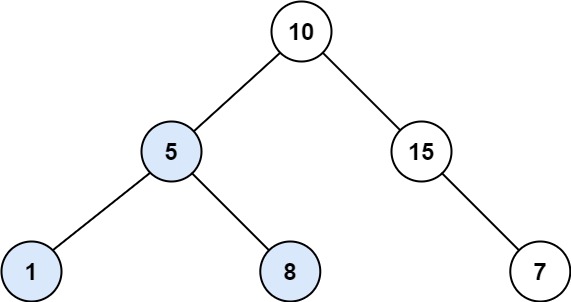Given the root of a binary tree, find the largest subtree, which is also a Binary Search Tree (BST), where the largest means subtree has the largest number of nodes.
A Binary Search Tree (BST) is a tree in which all the nodes follow the below-mentioned properties:
- The left subtree values are less than the value of their parent (root) node's value.
- The right subtree values are greater than the value of their parent (root) node's value.
Note: A subtree must include all of its descendants.
Example 1:
Input: root = [10,5,15,1,8,null,7] Output: 3 Explanation: The Largest BST Subtree in this case is the highlighted one. The return value is the subtree's size, which is 3.
Example 2:
Input: root = [4,2,7,2,3,5,null,2,null,null,null,null,null,1] Output: 2
Constraints:
- The number of nodes in the tree is in the range
[0, 104]. -104 <= Node.val <= 104
Follow up: Can you figure out ways to solve it with O(n) time complexity?
Related Topics:
Dynamic Programming, Tree, Depth-First Search, Binary Search Tree, Binary Tree
// OJ: https://leetcode.com/problems/largest-bst-subtree/
// Author: github.com/lzl124631x
// Time: O(N)
// Space: O(H)
class Solution {
int ans = 0;
array<int, 3> dfs(TreeNode *root) { // min, max, count. If invalid, count = -1
if (!root) return {INT_MAX,INT_MIN,0};
auto left = dfs(root->left), right = dfs(root->right);
bool valid = left[2] != -1 && right[2] != -1 && left[1] < root->val && right[0] > root->val;
if (valid) ans = max(ans, 1 + left[2] + right[2]);
return {left[2] ? left[0] : root->val, right[2] ? right[1] : root->val, valid ? 1 + left[2] + right[2] : -1};
}
public:
int largestBSTSubtree(TreeNode* root) {
dfs(root);
return ans;
}
};